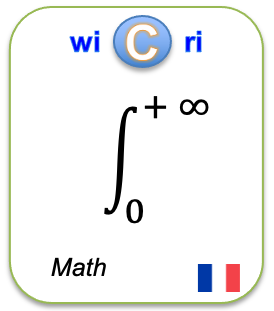Weakly Exponential Lie Groups
Identifieur interne : 001A46 ( Main/Merge ); précédent : 001A45; suivant : 001A47Weakly Exponential Lie Groups
Auteurs : Karl-Hermann Neeb [Allemagne]Source :
- Journal of Algebra [ 0021-8693 ] ; 1996.
English descriptors
- KwdEn :
- Abelian, Algebra, Base root, Base roots, Cartan, Cartan decomposition, Cartan subalgebra, Cartan subgroup, Cartan subgroups, Closure, Commutator, Commutator algebra, Corresponding cartan subgroup, Divisible roots, Exponential, Exponential function, Expy1, Finite center, Finite index, Full rank, Inner automorphisms, Isomorphic, Long base root, Long roots, Necessary condition, Neeb, Other hand, Proposition type, Real rank, Reducti, Reductive, Root system, Semisimple, Subalgebra, Subgroup, Subset, Zariski, Zariski closure.
- Teeft :
- Abelian, Algebra, Base root, Base roots, Cartan, Cartan decomposition, Cartan subalgebra, Cartan subgroup, Cartan subgroups, Closure, Commutator, Commutator algebra, Corresponding cartan subgroup, Divisible roots, Exponential, Exponential function, Expy1, Finite center, Finite index, Full rank, Inner automorphisms, Isomorphic, Long base root, Long roots, Necessary condition, Neeb, Other hand, Proposition type, Real rank, Reducti, Reductive, Root system, Semisimple, Subalgebra, Subgroup, Subset, Zariski, Zariski closure.
Abstract
Abstract: In this paper we list all simple real Lie algebras g for which there exist connected Lie groups with dense images of the exponential function. We also describe the simple real Lie algebras for which the exponential functions of the associated simply connected Lie groups have dense images. Let us say that a Lie group is weakly exponential if the image of its exponential function is dense. Hofmann and Mukherjea (On the density of the image of the exponential function,Math. Ann.234(1978), 263–273) show how to reduce the problem of determining whetherGis weakly exponential to the semisimple case. We also give some methods which are useful in determining whether a reductive Lie group is weakly exponential or not. Our method is based on the fact that a maximal rank subgroup of a weakly exponential Lie group inherits the property of being weakly exponential. This finally permits us to characterize the reductive Lie algebras having a weakly exponential group of inner automorphisms as those where the centralizer of the compact part of a maximally non-compact Cartan subalgebra has a commutator algebra isomorphic to a product of sl(2,R)-factors. For the groups Sl(n,R), Sp(n,R), and SO(p,q)0, 2≤p,q,p,qeven, Hofmann and Mukherjea show that they are not weakly exponential. For the other classical groups the results of Đokovic (The interior and the exterior of the image of the exponential map in classical Lie groups,J. Algebra112(1988), 90–109) provide information as to whether they are weakly exponential or not. It is a classical results that complex and compact simple Lie groups are weakly exponential.
Url:
DOI: 10.1006/jabr.1996.0015
Links toward previous steps (curation, corpus...)
- to stream Istex, to step Corpus: 000483
- to stream Istex, to step Curation: 000483
- to stream Istex, to step Checkpoint: 001828
Links to Exploration step
ISTEX:173FF38D2DEC34459617F2CA9C4A9C75260E76D3Le document en format XML
<record><TEI wicri:istexFullTextTei="biblStruct"><teiHeader><fileDesc><titleStmt><title xml:lang="en">Weakly Exponential Lie Groups</title><author><name sortKey="Neeb, Karl Hermann" sort="Neeb, Karl Hermann" uniqKey="Neeb K" first="Karl-Hermann" last="Neeb">Karl-Hermann Neeb</name></author></titleStmt><publicationStmt><idno type="wicri:source">ISTEX</idno><idno type="RBID">ISTEX:173FF38D2DEC34459617F2CA9C4A9C75260E76D3</idno><date when="1996" year="1996">1996</date><idno type="doi">10.1006/jabr.1996.0015</idno><idno type="url">https://api.istex.fr/document/173FF38D2DEC34459617F2CA9C4A9C75260E76D3/fulltext/pdf</idno><idno type="wicri:Area/Istex/Corpus">000483</idno><idno type="wicri:explorRef" wicri:stream="Istex" wicri:step="Corpus" wicri:corpus="ISTEX">000483</idno><idno type="wicri:Area/Istex/Curation">000483</idno><idno type="wicri:Area/Istex/Checkpoint">001828</idno><idno type="wicri:explorRef" wicri:stream="Istex" wicri:step="Checkpoint">001828</idno><idno type="wicri:doubleKey">0021-8693:1996:Neeb K:weakly:exponential:lie</idno><idno type="wicri:Area/Main/Merge">001A46</idno></publicationStmt><sourceDesc><biblStruct><analytic><title level="a" type="main" xml:lang="en">Weakly Exponential Lie Groups</title><author><name sortKey="Neeb, Karl Hermann" sort="Neeb, Karl Hermann" uniqKey="Neeb K" first="Karl-Hermann" last="Neeb">Karl-Hermann Neeb</name><affiliation wicri:level="3"><country xml:lang="fr">Allemagne</country><wicri:regionArea>Mathematisches Institut, Universität Erlanger-Nürnberg, Bismarckstrasse 12, D-91054, Erlangen</wicri:regionArea><placeName><settlement type="city">Erlangen</settlement><region type="land" nuts="1">Bavière</region><region type="district" nuts="2">District de Moyenne-Franconie</region></placeName></affiliation></author></analytic><monogr></monogr><series><title level="j">Journal of Algebra</title><title level="j" type="abbrev">YJABR</title><idno type="ISSN">0021-8693</idno><imprint><publisher>ELSEVIER</publisher><date type="published" when="1996">1996</date><biblScope unit="volume">179</biblScope><biblScope unit="issue">2</biblScope><biblScope unit="page" from="331">331</biblScope><biblScope unit="page" to="361">361</biblScope></imprint><idno type="ISSN">0021-8693</idno></series></biblStruct></sourceDesc><seriesStmt><idno type="ISSN">0021-8693</idno></seriesStmt></fileDesc><profileDesc><textClass><keywords scheme="KwdEn" xml:lang="en"><term>Abelian</term><term>Algebra</term><term>Base root</term><term>Base roots</term><term>Cartan</term><term>Cartan decomposition</term><term>Cartan subalgebra</term><term>Cartan subgroup</term><term>Cartan subgroups</term><term>Closure</term><term>Commutator</term><term>Commutator algebra</term><term>Corresponding cartan subgroup</term><term>Divisible roots</term><term>Exponential</term><term>Exponential function</term><term>Expy1</term><term>Finite center</term><term>Finite index</term><term>Full rank</term><term>Inner automorphisms</term><term>Isomorphic</term><term>Long base root</term><term>Long roots</term><term>Necessary condition</term><term>Neeb</term><term>Other hand</term><term>Proposition type</term><term>Real rank</term><term>Reducti</term><term>Reductive</term><term>Root system</term><term>Semisimple</term><term>Subalgebra</term><term>Subgroup</term><term>Subset</term><term>Zariski</term><term>Zariski closure</term></keywords><keywords scheme="Teeft" xml:lang="en"><term>Abelian</term><term>Algebra</term><term>Base root</term><term>Base roots</term><term>Cartan</term><term>Cartan decomposition</term><term>Cartan subalgebra</term><term>Cartan subgroup</term><term>Cartan subgroups</term><term>Closure</term><term>Commutator</term><term>Commutator algebra</term><term>Corresponding cartan subgroup</term><term>Divisible roots</term><term>Exponential</term><term>Exponential function</term><term>Expy1</term><term>Finite center</term><term>Finite index</term><term>Full rank</term><term>Inner automorphisms</term><term>Isomorphic</term><term>Long base root</term><term>Long roots</term><term>Necessary condition</term><term>Neeb</term><term>Other hand</term><term>Proposition type</term><term>Real rank</term><term>Reducti</term><term>Reductive</term><term>Root system</term><term>Semisimple</term><term>Subalgebra</term><term>Subgroup</term><term>Subset</term><term>Zariski</term><term>Zariski closure</term></keywords></textClass><langUsage><language ident="en">en</language></langUsage></profileDesc></teiHeader><front><div type="abstract" xml:lang="en">Abstract: In this paper we list all simple real Lie algebras g for which there exist connected Lie groups with dense images of the exponential function. We also describe the simple real Lie algebras for which the exponential functions of the associated simply connected Lie groups have dense images. Let us say that a Lie group is weakly exponential if the image of its exponential function is dense. Hofmann and Mukherjea (On the density of the image of the exponential function,Math. Ann.234(1978), 263–273) show how to reduce the problem of determining whetherGis weakly exponential to the semisimple case. We also give some methods which are useful in determining whether a reductive Lie group is weakly exponential or not. Our method is based on the fact that a maximal rank subgroup of a weakly exponential Lie group inherits the property of being weakly exponential. This finally permits us to characterize the reductive Lie algebras having a weakly exponential group of inner automorphisms as those where the centralizer of the compact part of a maximally non-compact Cartan subalgebra has a commutator algebra isomorphic to a product of sl(2,R)-factors. For the groups Sl(n,R), Sp(n,R), and SO(p,q)0, 2≤p,q,p,qeven, Hofmann and Mukherjea show that they are not weakly exponential. For the other classical groups the results of Đokovic (The interior and the exterior of the image of the exponential map in classical Lie groups,J. Algebra112(1988), 90–109) provide information as to whether they are weakly exponential or not. It is a classical results that complex and compact simple Lie groups are weakly exponential.</div></front></TEI></record>Pour manipuler ce document sous Unix (Dilib)
EXPLOR_STEP=$WICRI_ROOT/Wicri/Mathematiques/explor/BourbakiV1/Data/Main/Merge
HfdSelect -h $EXPLOR_STEP/biblio.hfd -nk 001A46 | SxmlIndent | more
Ou
HfdSelect -h $EXPLOR_AREA/Data/Main/Merge/biblio.hfd -nk 001A46 | SxmlIndent | more
Pour mettre un lien sur cette page dans le réseau Wicri
{{Explor lien
|wiki= Wicri/Mathematiques
|area= BourbakiV1
|flux= Main
|étape= Merge
|type= RBID
|clé= ISTEX:173FF38D2DEC34459617F2CA9C4A9C75260E76D3
|texte= Weakly Exponential Lie Groups
}}
|
| This area was generated with Dilib version V0.6.33. | |



